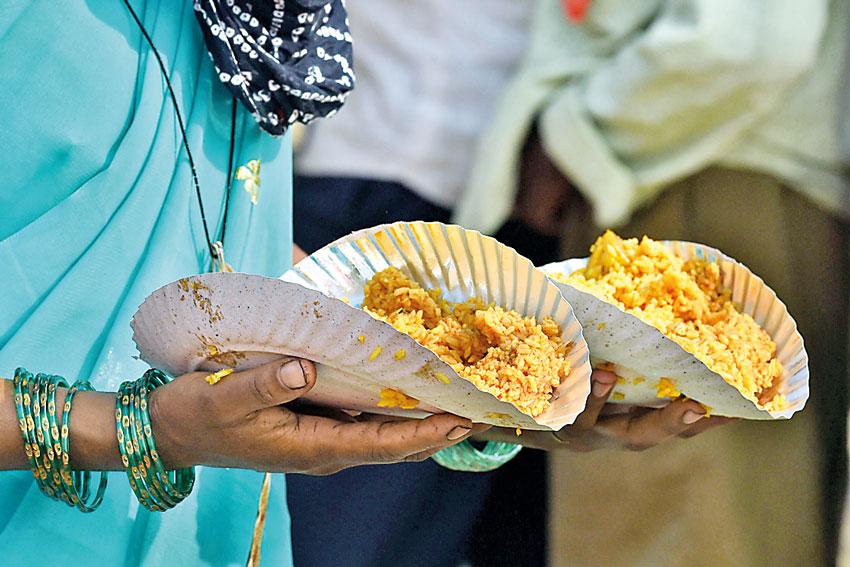30 May 2020 - {{hitsCtrl.values.hits}}

There’s no point talking about COVID-19’s impact on the economy without talking about what the economy looked like, and how it operated, before the pandemic
(Pix AFP)
 Gunadasa Amarasekara in a thoughtful piece (“Coronawa ugannana padam”, translated as “Lessons from Corona” and referenced in a partial critique of it by Dayan Jayatilleka, “Government’s lopsided model, Opposition’s boycott blunder”) remembers how, after the end of the war, he hoped that the president in his victory speech would underscore an inescapable fact: that terrorism in the north as well as the south had been fuelled by “this vicious economy” and neoliberal reforms injected into it after 1977. Now there is much in Amarasekara’s article that I agree and disagree with, yet there is also much that compels one to see things differently. Amarasekara’s critics, on the other hand, see no redeeming value in it, tossing it aside as Sinhala Buddhist nationalist: a label liberally pasted over the entire Jathika Chintanaya campaign, a blanket generalisation.
Gunadasa Amarasekara in a thoughtful piece (“Coronawa ugannana padam”, translated as “Lessons from Corona” and referenced in a partial critique of it by Dayan Jayatilleka, “Government’s lopsided model, Opposition’s boycott blunder”) remembers how, after the end of the war, he hoped that the president in his victory speech would underscore an inescapable fact: that terrorism in the north as well as the south had been fuelled by “this vicious economy” and neoliberal reforms injected into it after 1977. Now there is much in Amarasekara’s article that I agree and disagree with, yet there is also much that compels one to see things differently. Amarasekara’s critics, on the other hand, see no redeeming value in it, tossing it aside as Sinhala Buddhist nationalist: a label liberally pasted over the entire Jathika Chintanaya campaign, a blanket generalisation.

I suggested in my last column that at the end of the 1980s there was no tenable radical Left outfit to take on the ruling regime in Sri Lanka. The many “post-Marxisms” and “postmodernisms” which had cropped up during that time were hardly enough to combat the capitalist framework, to delink from that framework. This was not, of course, a phenomenon peculiar or unique to Sri Lanka, since for the Third World in general, the 1980s ushered in the rise of neoliberal authoritarianism on the one hand and the descent of viable Marxist alternatives on the other. The intellectual void this resulted in was eventually filled by what Samir Amin referred to as “religious antiquarians.”
He would, undoubtedly, have classed the Jathika Chintanaya project under the latter term, as much as he did cultural revival movements in the Middle East. Amin moreover contended that there could be no positive outcome from the emergence of such ethno-nationalist movements. The failure of alternative political outfits, on the other hand, was that they did not go enough by way of criticising capitalism and globalisation: because of this weakness, the only viable counterweight to the establishment, at least in the eyes of people, lay in those same ethno-nationalist movements. This is something historians and columnists writing diatribes against the likes of Amarasekara have so far ignored.
Amarasekara’s most important argument was the need for industry in the country. He underscored this from an ethnic vantage point

Here we must acknowledge two things: brushing aside a nationalist narrative with simplifications will in the long run shore up support for it among not just ethno-zealots, but also intellectuals, and failing to listen to what its narrators have to say, about culture, but also about politics, economics, and our way of life, runs the risk of ignoring certain historical realities. History is important. Marx emphasised this, and so did Santayana. If we continue to marginalise it when talking about “the way out” for our collective political, economic, and cultural impasse, we are doomed to repeat it, whether as farce or as tragedy. There’s hence no point talking about COVID-19’s impact on the economy without talking about what the economy looked like, and how it operated, before the pandemic. Gunadasa Amarasekara has made that point.
The 1980s and 1990s saw the collapse of communism and, throughout much of the Third World, the rise of organisations, think-tanks, and agencies which continued to call themselves Marxist or radical while soliciting funds from NGOs and donors whose objectives were certainly not, by any stretch of the imagination, Marxist or radical. These outfits propounded alternatives to the capitalist mode of production and accumulation which didn’t really question that setup, but rather offered piecemeal solutions that effectively abandoned the class struggle. To put this very succinctly, in the 1980s much of the Left in Sri Lanka forwent on class struggles and issues of relative disadvantage, to focus almost exclusively on what critics have called “micro-politics”. Historical realities were jettisoned by the new left formations, while class relations were swept aside in favour of ethnic politics. Gunadasa Amarasekara’s and Nalin de Silva’s contribution at this critical historical juncture was that they came up with a programme which could counter and respond to these distortions.
Amarasekara’s most important argument was the need for industry in the country. He underscored this from an ethnic vantage point, seeing in industrialisation a means of correcting historical wrongs committed against Sinhala Buddhists, but the fact is that he underscored it. The two can’t actually be separated. To put it simply, Amarasekara and the JC offered a way out of sorts: local industry.
Marxists and former Marxists – including card-carrying members of the JVP – were, on the other hand at this point, coming up with their own solutions and interpretations of history, countering the JC view of the economy. But their counter-narrative stood on shaky grounds and premises. Amarasekara may be accused of peddling ethnic supremacy in his prescriptions for the economy; he cannot, however, be accused of distorting and misreading history.
The “radicals” or “freethinkers”, as their supporters like to call them, give us either of two answers: the British, by supposedly destroying feudal, pre-capitalist social relations, developed the country; and modernisation and modernity, as defined of course by the West, must be embraced if we are to prevent a reversal to such primitive pasts. Those who make the first argument will claim that by the time we got independence, “we” had the best harbour, health service, and road network in Asia, while those who make the second argument will claim that capitalism, however exploitative, is preferable to upholding traditional social relations. So when, in the 1990s, multinational capital inundated the country, “radical intellectuals” observed that as harmful as its effects may be, such capital should be allowed to flood in since it marginalises, and destroys, the so-called traditional order. That “traditional order” for them included Buddhist monks and nationalist agitators, when the truth is that it included powerful businessmen, speculators, and multilateral agencies which lack transparency and accountability. By privileging identity politics over class disadvantage, the “intellectuals” were opting not to see the latter.
For that reason, it doesn’t really surprise me that a series of videos about the “dark closed” days of the Sirimavo Bandaranaike regime, scripted from an anti-left standpoint, should feature a prominent “Left” radical. Not that the JC’s reading of that era is right either: Amarasekara, for instance, praises Bandaranaike while arguing that the Marxists took too much control over her programme and made a total mess of it, when what happened was that the Marxists, facing insurmountable obstacles in the form of global famines, oil shortages, and continued pummelling of the economy by intermediaries which manipulated the system for their benefit (something S. B. D. de Silva noted in an interview in 2017, before his passing away), couldn’t implement their program in full. But Amarasekara didn’t sell himself out to propagate a deliberately one-sided view of history. There we must admit an inconvenient truth: many of our radicals, far from agitating for real change, have sold themselves out to pre-empt change. Social science, ergo, has been deployed to prop up the status quo. This is a tragedy.
UDAKDEV1@
GMAIL.COM
28 Nov 2024 7 minute ago
28 Nov 2024 15 minute ago
28 Nov 2024 1 hours ago
28 Nov 2024 3 hours ago
28 Nov 2024 4 hours ago